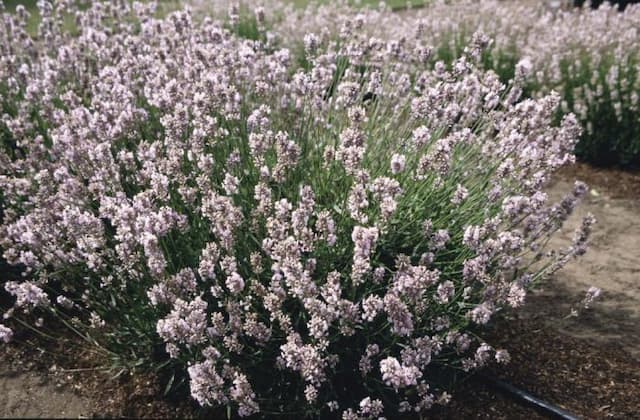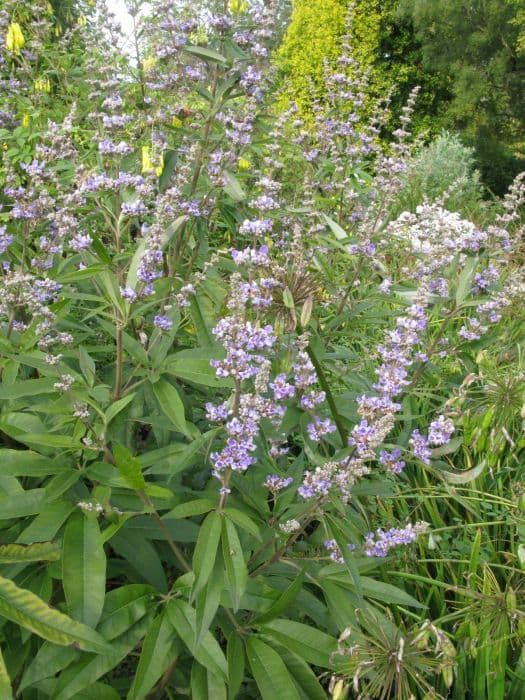Coleus Solenostemon scutellarioides 'Gay's Delight'

ABOUT
'Gay's Delight' is a variety of coleus that boasts vibrant and decorative foliage, which is the most striking feature of the plant. The leaves of this coleus are broad and heart-shaped with a unique color palette that predominantly showcases different shades of green. Each leaf is intricately patterned with a bright, lime-green to yellowish center which is bordered by a darker green, creating a sharp contrast. The margin may sometimes exhibit subtle hints of other colors but remains predominantly green. The overall effect of the leaves' coloring presents a high visual impact that is both lively and refreshing, making 'Gay's Delight' a popular choice for adding a splash of color to gardens or as a statement piece in container plantings. The texture of the foliage is somewhat velvety, and the edges of the leaves may be lightly scalloped, contributing further to the ornamental quality of the plant.
About this plant
 Names
NamesFamily
Lamiaceae.
Synonyms
Coleus, Flame Nettle, Painted Nettle.
Common names
Coleus blumei, Coleus blumei var. verschaffeltii, Coleus hybridus, Coleus scutellarioides, Coleus verschaffeltii, Plectranthus scutellarioides.
 Toxicity
ToxicityTo humans
Coleus, the most common common name of Solenostemon scutellarioides 'Gay's Delight', is generally considered non-toxic to humans. However, it's always advisable to avoid ingesting plants that are not meant for consumption, as they can potentially cause a mild digestive upset or an allergic reaction in sensitive individuals.
To pets
Coleus is known to be toxic to pets such as dogs and cats. If ingested, it can cause vomiting, diarrhea, depression, anorexia, or occasionally, more severe symptoms like a slower heart rate. If you suspect your pet has ingested coleus, it is best to consult a veterinarian.
 Characteristics
CharacteristicsLife cycle
Perennials
Foliage type
Evergreen
Color of leaves
Varies
Height
2 feet [60 cm]
Spread
2 feet [60 cm]
Plant type
Herb
Hardiness zones
Varies
Native area
Southeast Asia
Benefits
 General Benefits
General Benefits- Aesthetics: The Coleus 'Gay's Delight' is known for its vibrant and variegated foliage, adding a splash of color to garden beds, containers, and indoor spaces.
- Low Maintenance: As a robust and adaptable plant, it generally requires minimal care beyond regular watering and partial shade, making it suitable for gardeners of all skill levels.
- Versatility: It can be used in a variety of garden designs, including borders, mass plantings, and as a feature plant due to its striking foliage.
- Season-Long Interest: This plant maintains its ornamental appeal throughout the growing season, from spring until frost, providing long-term visual interest.
- Attracts Pollinators: While primarily grown for its leaves, Coleus can produce flowers that attract bees and other pollinators, benefiting the garden ecosystem.
 Medical Properties
Medical PropertiesThis plant is not used for medical purposes.
 Air-purifying Qualities
Air-purifying QualitiesThis plant is not specifically known for air purifying qualities.
 Other Uses
Other Uses- Coleus 'Gay's Delight' can be used as a natural dye, providing a range of hues from its leaves when processed correctly.
- In a terrarium, Coleus 'Gay's Delight' adds vibrant color and leaf texture for visual interest and contrast amongst more typical terrarium plants.
- The plant can be used in educational settings, helping students to learn about plant propagation from cuttings as it roots easily in water or soil.
- Coleus 'Gay's Delight' serves as an indicator of light levels; the vibrancy of its foliage will diminish if light conditions are too low, suggesting the need for better location or additional lighting.
- They are commonly used in temporary garden displays or events, as they offer immediate visual impact due to their brightly colored leaves.
- As a compliment to autumn decor, the vivid foliage of Coleus 'Gay's Delight' can mimic the colors of fall leaves for indoor decorating schemes.
- Coleus 'Gay's Delight' can be used in container gardening for balconies or patios, where space is limited but bright foliage is desired.
- The plant can play a role in companion planting, being used to distract or attract pests away from other plants.
- Coleus 'Gay's Delight' can be integrated into performance art or living sculptures due to its color and form, adding a living element to creative displays.
- For someone practicing the art of Bonsai, the Coleus 'Gay's Delight' could serve as an unconventional subject due to its quick growth and ease of training.
Interesting Facts
 Feng Shui
Feng ShuiThe Coleus 'Gay's Delight' is not used in Feng Shui practice.
 Zodiac Sign Compitability
Zodiac Sign CompitabilityThe Coleus 'Gay's Delight' is not used in astrology practice.
 Plant Symbolism
Plant Symbolism- Creativity and Innovation: Coleus, which is the most common name for Solenostemon scutellarioides, often symbolizes the spark of creativity due to its vibrant and variegated leaves.
- Diversity and Uniqueness: The vast array of patterns and colors in Coleus represents diversity and the beauty of being unique.
- Flexibility and Adaptability: Coleus can thrive in various light conditions, symbolizing flexibility and the ability to adapt to changing environments.
 Water
WaterThe Coleus (Solenostemon scutellarioides 'Gay's Delight') prefers consistently moist soil, so it should be watered regularly, but take care not to overwater. A good approach is to check the soil moisture every few days and water when the top inch of soil feels dry to the touch. Depending on the environment, indoor Coleus might need watering once a week, with approximately 8-16 ounces of water for a standard 6-8 inch potted plant. Adjust the amount as necessary for larger pots, ensuring you're not leaving the plant in standing water which can lead to root rot.
 Light
LightColeus thrives in bright, indirect light but can tolerate a wide range of lighting conditions, making it a versatile houseplant. For optimal growth, place 'Gay's Delight' in a spot where it will receive plenty of light without direct sunlight exposure, which can bleach its vibrant leaves. East or north-facing windows are usually ideal locations for Coleus, providing it with the light it needs without the harsh midday sun.
 Temperature
TemperatureColeus plants prefer warm temperatures and do not tolerate cold well. The ideal temperature range for Solenostemon scutellarioides 'Gay's Delight' is between 60 and 75 degrees Fahrenheit. These plants should be protected from temperatures below 50 degrees Fahrenheit, as they may suffer damage or potentially die if exposed to frost.
 Pruning
PruningPruning Coleus, including 'Gay's Delight', promotes bushier growth and prevents the plant from becoming leggy. Pinch or cut back the tops of the stems every few weeks during the growing season. Pruning is best done in the spring or early summer, which is the plant's active growth period, encouraging branching and denser foliage.
 Cleaning
CleaningAs needed
 Soil
SoilThe best soil mix for Coleus 'Gay's Delight' is well-draining, rich in organic matter, and should hold moisture without becoming waterlogged. A mix of two parts peat moss or coco coir, one part perlite or sand, and one part compost or well-rotted manure is ideal. The soil pH should range between 6.0 and 7.0 for optimal growth.
 Repotting
RepottingColeus 'Gay's Delight' should be repotted approximately every 1-2 years, or when it outgrows its current container. The best time to repot is in the spring or early summer, which will give the plant time to establish in its new pot before the active growing period.
 Humidity & Misting
Humidity & MistingColeus 'Gay's Delight' thrives in high humidity conditions, ideally between 50% and 70%. If the indoor air is too dry, consider using a humidifier or placing the plant on a tray filled with pebbles and water to increase the humidity around the plant.
 Suitable locations
Suitable locationsIndoor
Place in bright, indirect light and keep soil moist.
Outdoor
Grow in part shade to full sun and ensure soil drains well.
Hardiness zone
10-11 USDA
 Life cycle
Life cycleColeus 'Gay's Delight' begins life as a small seed, which, when sown in warm, moist soil, germinates within a week or two. The seedling stage is marked by the emergence of the plant's distinctive foliage, which continues to grow and become more vibrant as the plant matures. As a juvenile, the coleus plant develops a sturdy stem and begins to form a bushy shape, a process that typically occurs over several weeks to a few months. Reaching maturity, 'Gay's Delight' displays its full splendor with large, brightly colored leaves and may attain a height of up to 24-30 inches. If allowed to flower, small, insignificant flowers can be produced, although they are often pinched off to encourage fuller leaf growth. Finally, as an annual or tender perennial, the life of 'Gay's Delight' ends with the onset of frost or declining conditions, at which point it can be propagated from cuttings to continue its cycle.
 Propogation
PropogationPropogation time
Spring-Summer
The most popular method for propagating Solenostemon scutellarioides 'Gay's Delight', commonly known as Coleus, is by stem cuttings. To do this, a healthy stem tip about 4-6 inches (10-15 cm) long is snipped below a leaf node, removing the lower leaves while leaving the top ones intact. The cut end of the stem can be dipped into rooting hormone powder to encourage root growth, although coleus often roots easily without it. The stem is then inserted into a moist potting mix and covered with plastic to retain humidity. The cutting should be kept in bright, indirect light at a warm temperature, and in a few weeks, it will develop roots and can be transplanted.









